Right diagnostic test and right treatment at the right time can prevent antimicrobial resistance

BOBBY RAMAKANT – CNS
New guidelines were launched in India’s capital Delhi to help healthcare personnel rightly diagnose and treat people in a timely manner. Failure to do so is fuelling antimicrobial resistance (AMR). Early and accurate diagnosis and treatment (without any delay), with medicines that work on a person, along with standard infection control and disease prevention efforts, remain a cornerstone for public health. And yet this is a distant dream for many in need.
Underlining the human impact of late and/or incorrect diagnosis, and misuse or irrational use of medicines on human beings, Dr Sangeeta Sharma (who led the guideline development process) said: “How can we ignore the substantial impact of poor quality of care on premature mortality rates – 60% of untimely deaths result from treatable conditions that are not addressed correctly.” Dr Sangeeta Sharma is a senior Professor at the Institute of Human Behaviour and Allied Sciences (IHBAS), and President (Honorary) of the Delhi Society for Promotion of Rational Use of Drugs (DSPRUD).
She emphasised the importance of the new guidelines “as a reliable tool to improve healthcare quality and patient safety; providing clear, evidence-based guidelines tailored to the Indian context and helping clinicians avoid irrational or inappropriate prescribing practices.”
Why are these guidelines important?
These guidelines are an important tool to help the healthcare workers at all levels to use the right diagnostic test and offer right treatment in a timely manner – and help combat antimicrobial resistance (AMR).
Protect the medicines that protect us -Shobha Shukla
Let us understand how misuse or overuse of medicines result in antimicrobial resistance (or drug resistance) and is now ranked amongst the top-ten global health threats.
“Antimicrobial Resistance (AMR) is a problem driven by misuse and overuse of antimicrobial medicines, including antibiotics and antivirals, and results in critical medicines losing effectiveness to treat infections,” said Thomas Joseph, Head, AMR Awareness, Advocacy and Campaigns, World Health Organization (WHO).
“AMR inflicts significant mortality, morbidity and economic loss in low- and middle-income countries, including India. Several countries in Asia and Africa have observed a worrying trend of increasing drug resistance, while progress towards AMR containment efforts remain scattered and fragmented,” said Dr Kamini Walia who is the Convener and Co-Chairperson of Scientific Committee of Global AMR Media Alliance (GAMA) and a senior AMR scientist at the Indian Council of Medical Research (ICMR).
Agrees Thomas: “AMR is associated with 5 million deaths a year. Besides this, there is the huge burden of morbidity and healthcare expenditure that can affect severely household welfare. The World Bank estimates that Global GDP could fall by US$ 1 to US$ 3.4 trillion annually after 2030 due to AMR,” he added. The World Bank estimates that an additional 24 million people would be forced into extreme poverty by 2030 if no action is taken on AMR today.
7th Edition of the Standard Treatment Guidelines
The 7th Edition of the “Standard Treatment Guidelines: A Comprehensive Resource for Informed Clinical Decision-Making”, was developed by Delhi Society for Promotion of Rational Use of Drugs (DSPRUD) and launched at Lady Hardinge Medical College in Delhi, India. The guideline launch took place at the 7th Diagnostic Stewardship Programme to combat AMR.
Did the World not know about Gandhi till the film on him was released?
These guidelines encompass over 350 priority diseases across 11 medical super-specialties, providing medical experts with invaluable insights into clinical manifestations, therapeutic advances, patient management, and patient education.
Dr Atul Kotwal, Executive Director, National Health Systems Resource Centre (NHSRC is a technical support institute with National Health Mission of Government of India) said that NHSRC and DSPRUD are partners in disseminating and implementing Standard Treatment Guidelines effectively in clinical practice.
Over the past two years, these joint initiatives (guidelines and diagnostic stewardship programmes) have engaged over 10,000 healthcare professionals from across India, demonstrating the demand for continuous professional development and adherence to standardized treatment protocols.
Absence of diagnosis and AMR
In the absence of a diagnosis, there is overuse of antibiotics (or other antimicrobials such as antivirals, antifungals, or antiparasitics), said Dr Ranga Reddy Burri, President, Infection Control Academy in India. “Diagnostic uncertainty is influenced by factors such as challenges in diagnosing infections, fear of missing a diagnosis, limited access to rapid diagnostic tests, reliance on clinical judgment, and patient expectations.”
Inter-relatedness of diagnostic stewardship and adherence to standard treatment guidelines is paramount in ensuring effective patient care, said Dr Sarita Beri, Director, Lady Hardinge Medical College. By promoting accurate diagnosis, informed treatment decisions, and responsible antimicrobial use, these initiatives aim to enhance patient safety and combat the spread of AMR.
Dr Sangeeta Sharma said that these standard treatment guidelines have been formulated to:
– Assist clinicians in making informed and effective patient management decisions as they serve as a guiding light across various levels of healthcare- from primary health care to tertiary care health centres
– Ensure their reliability and relevance in today’s dynamic healthcare environment, as they are meticulously crafted through the collaboration and contribution of a multitude of experts and reviewers
– Offer reader-friendly, up-to-date, and evidence-based expert information at the point of care
– Include pharmacological and non-pharmacological management strategies tailored to different healthcare settings, along with clear goals of treatment, criteria for assessing response to therapy, step-up and step-down approaches, referral criteria, and guidelines for follow-up.
Advancing AMR stewardship when multiple medical disciplines are practiced in India is a challenge. Dr Sangeeta Sharma added that “There is a significant variation in clinical practice, where different practitioners may adopt diverse approaches to treating similar conditions, leading to inconsistencies in patient care at times. This variation often stems from a reliance on past practices rather than evidence-based guidelines, resulting in treatments that may not reflect the latest research or best practices.”
Furthermore, the rising demand for healthcare services has put a strain on resources, necessitating more efficient and standardised approaches to treatment in order to effectively meet patient needs.
Diagnostic delays = Catastrophic costs and Access versus Excess paradox
When we fail to diagnose a disease timely and accurately, we add to diagnostic delays, fuel the spread of disease (either in the affected person in case of a non-communicable disease or in the community as well if it is an infectious one) – and this results in avoidable human suffering, as well as an onslaught of catastrophic cost – all of this is so avoidable.
Full Biography of Famous Dutch Actor Donny Roelvink
Dr Sharma shared that “Access versus Excess paradox highlights the issue where, despite broad availability of medications, there can be either a lack of access to necessary drugs or an excess leading to inappropriate use. The abundance of different types of pills, coupled with free over-the-counter availability, further contributes to misuse and potential harm.”
In addition, there are issues with labelling, packaging, and nomenclature of medicines that create confusion and increase the risk of medication errors.
Additionally, factors such as illegible handwriting in prescriptions, incomplete knowledge of drug names, and the similarity in clinical use of different medications exacerbate the risk of errors.
“Standard Treatment Guidelines significantly enhance the value of health systems by promoting consistency, cost-effectiveness, and quality in patient care. They provide a framework for uniform care delivery, ensuring that patients receive evidence-based treatments irrespective of the healthcare provider or location,” said Dr Sharma.
What’s new in the 7th edition of the guidelines?
Dr Sharma worked with a team of medical experts from across super-specialities in the country to revise the latest guidelines. Dr Kamal Kishore Chopra, who is the former Director of the prestigious New Delhi TB Centre and part of the leadership of TB Association of India was also a part of the experts’ group that shaped the 7th edition of the guidelines. Dr Kuldeep Singh Sachdeva, who is the former head of Indian government’s TB and HIV programmes (earlier served as Deputy Director General at the Ministry of Health and Family Welfare, Government of India) and former Southeast Asia Director of International Union Against Tuberculosis and Lung Disease (The Union) was also part of the experts’ group that worked on the guidelines. Dr Rajendra Prasad, Dr BC Roy National Awardee and former Director of Vallabhbhai Patel Chest Institute in Delhi and former Head of Respiratory Medicine, King George’s Medical University (KGMU) was also part of the guideline development panel of experts.
Dr Sangeeta Sharma said: “The 7th edition of the standard treatment guidelines introduces several key updates and new features to ensure comprehensive and up-to-date medical guidance. All sections have been thoroughly revised and updated with the latest recommendations, including new algorithms and evidence-based practices for critical areas such as hypertension, sepsis, burns, trauma, bleeding disorders like haemophilia, chronic obstructive pulmonary disease (COPD), tuberculosis, HIV/AIDS, and dental conditions.”
“New sections have been added, focusing on palliative care, with a special emphasis on opioid use, and psychiatric emergencies, including management of patients with suicide risk, delirium tremens (severe form of alcohol withdrawal), acute agitation, extra-pyramidal syndrome, neuroleptic malignant syndrome, lithium toxicity, and valproate toxicity,” added Dr Sharma.
Updates also extend to surgical conditions such as urolithiasis (formation of urinary stones) and benign prostatic hyperplasia (enlarged prostate gland).
“These guidelines offer a detailed, practical approach to diagnosing and managing a wide range of conditions. For example, the hypertension section emphasizes a comprehensive diagnosis process, outlining common mistakes while measuring the blood pressure (BP) and the need for multiple readings to avoid misdiagnosis. It also provides a step-by-step approach to managing hypertension, diabetes, and infections, highlighting the importance of lifestyle modifications and evidence-based treatment protocols.”
Another notable feature is its detailed guidance on handling snake bites and dog bites, including crucial do’s and don’ts to prevent complications and ensure effective initial treatment.
For trauma management, the book offers clear instructions on first aid measures, ensuring timely and effective response to injuries.
This edition also includes comprehensive coverage of common pitfalls and precautions, ensuring that healthcare professionals can provide accurate and effective care in various clinical scenarios.
7th meeting on diagnostic stewardship
Diagnostic stewardship involves ordering the right tests for the right patient at the right time and interpreting the results to provide the right antibiotic in the right dose, said Dr Sangeeta Sharma, key organiser of the 7th Diagnostic Stewardship meet.
“The aim of this meeting is to foster a culture of responsible antimicrobial use by equipping healthcare professionals with the knowledge and skills needed to order the right tests, interpret results accurately, and select the appropriate antimicrobial for treatment” said Dr Renu Gupta, faculty at IHBAS and Secretary of DSPRUD.
‘Just in case’ medicine
Diagnostic uncertainties have emerged as a crucial factor to fuel the inappropriate use of antimicrobials. Doctors sometimes prescribe antimicrobials as a precautionary measure, known as “just in case” medicine, due to an inability to establish a confirmed diagnosis. This is often due to suboptimal availability of laboratory support or the misinterpretation of laboratory reports.
For example, microscopy test underperforms in diagnosing TB. That is why WHO has called upon the countries to completely replace microscopy with WHO-recommended molecular tests. We have to do so to stop missing TB cases among those who take a TB test. More importantly, we have to take the lab to the people by deploying point-of-care and point-of-need, laboratory independent and battery-operated, decentralised TB screening and diagnostic tools- like ultraportable x-rays and WHO recommended Truenat (World’s only point-of-care and decentralised molecular test for TB). Truenat is also being used on solar power in several countries such as Democratic Republic of the Congo and Nigeria. We have to find all TB, treat all TB and prevent all transmission of TB in a people-centred, rights-based and gender transformative manner.
But we are not doing as good as we can with existing tools. As per the latest WHO Global TB Report (2023), we could diagnose less than HALF of people with drug-resistant TB: out of 410,000, globally we could just diagnose only 170,000 in 2022. Imagine the diagnostic delays and catastrophic costs, as well as human suffering, for 170,000 people with drug-resistant TB, and for the remaining people who were not even diagnosed or linked to therapy – and risk of further spread of infection and untimely death. All this could have been averted if we had diagnosed each one of them accurately and early, and linked them to effective treatment, care and support. Hugely missed opportunity it is, as we believe at CNS and Global Call to Find All TB.
A Call to Action
Addressing AMR is a shared responsibility. Health authorities, healthcare providers, and the public must work together to promote the responsible use of antimicrobials. Enhancing microbiological laboratory infrastructure, training healthcare professionals in diagnostic stewardship, and raising awareness about AMR are critical steps towards this goal.
A ray of hope lies in Dr Sangeeta Sharma’s led initiative to train healthcare workers to combat AMR. To date, her course has trained over 1,000 doctors and engaged 1,600 nurses and laboratory technicians in diagnostic stewardship.
Judicious use of medicines, along side other meausres, will go a long way in controlling antimicrobial resistance and protecting human lives!
Bobby Ramakant – CNS (Citizen News Service)
(Bobby Ramakant is part of editorial team of CNS (Citizen News Service) and a Board member of Global Antimicrobial Resistance Media Alliance (GAMA) and Asia Pacific Media Alliance for Health and Development (APCAT Media). Follow him on Twitter @BobbyRamakant)



